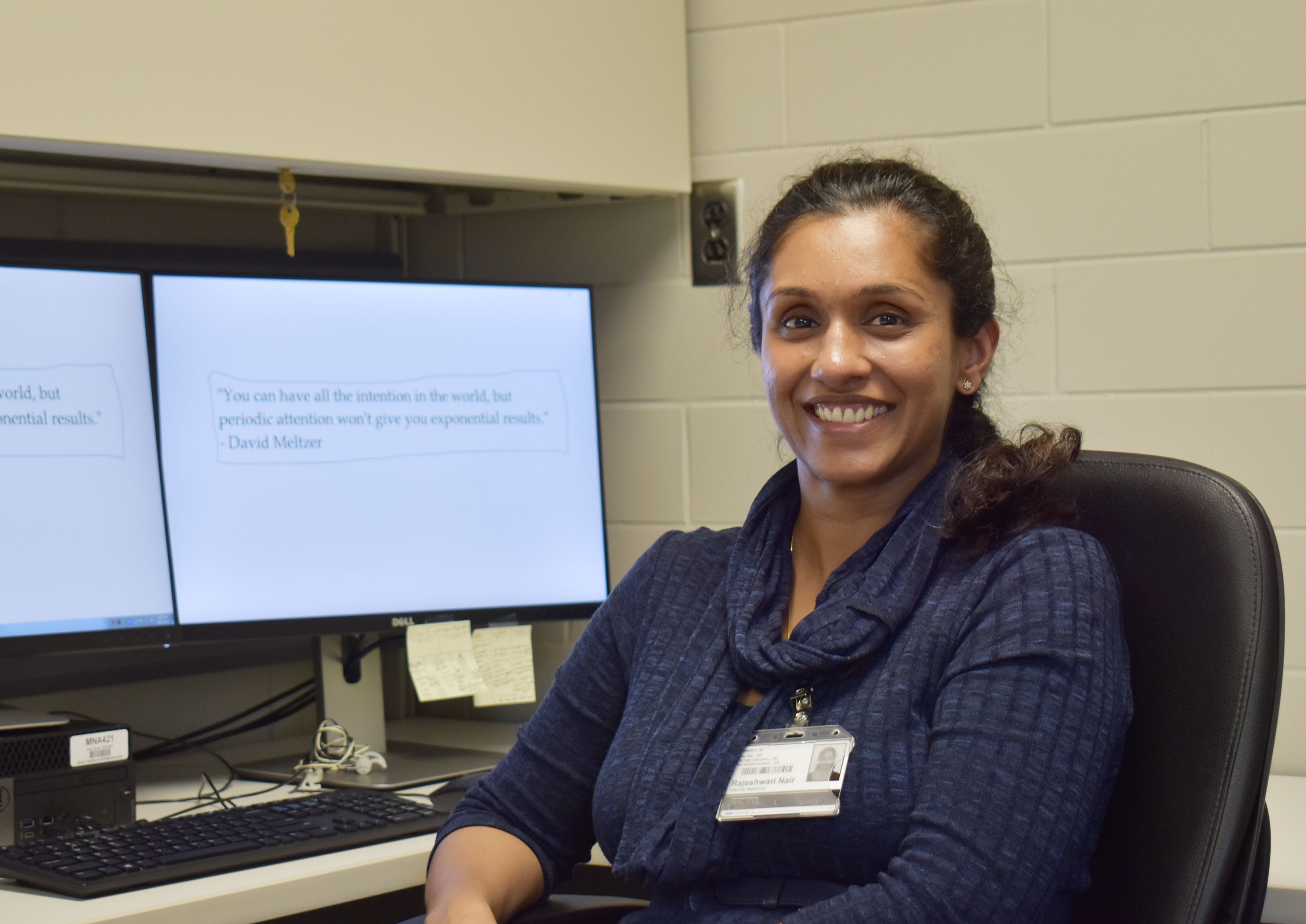Rajeshwari Nair, MBBS, PhD, understands that the bigger picture is made up of many details and that effective solutions require a grasp of both the bird’s-eye-view as well as the one through a microscope. As an Associate in the Division of General Internal Medicine, Nair works closely with a number of other investigators blending those two views—the high-level, data-filled perspective and the qualitative, close-up one—to produce solutions designed to improve patient safety.
Getting to public health, getting to Iowa
That focus, infection control in health services research, was not always Nair’s plan. After completing medical school in Mumbai, she worked as a resident physician caring for patients in both surgery and internal medicine in addition to a required stint focused on public health. “It’s different in India, it is more of preventive and social medicine, going out and getting people immunized, that kind of a thing.” But the idea of having a larger impact on population health in addition to treating one patient at a time appealed to her, and she began to look at public health programs in the United States.
Nair worked as a research assistant in the School of Nursing while finishing her Master’s in Public Health at Northern Illinois University. It was while watching a video of a neurology study conducted at the University of Iowa that her supervisor was showing some students that she first learned about Iowa. “I remember thinking, ‘wow, that place is doing some cool work,’” she said. So when Iowa City came up in her search for PhD programs, it was an easy addition to her shortlist. “It felt like a sign.” It also helped, she joked, that her husband had been accepted to an Epidemiology program in Iowa’s College of Public Health.
The greatest impact
 Once here, Nair dove into assessing overall public health needs, but then she was able to work on an infectious diseases project and a passion was discovered. This, she thought, was the area of medicine she wanted to work in, seeing a greater potential for impact. “An acute condition can come and go, as opposed to a chronic one that heavily depends on modifications to lifestyle or behavior.” The challenge of an acute crisis represented by an infectious agent represented a stronger pull.
Once here, Nair dove into assessing overall public health needs, but then she was able to work on an infectious diseases project and a passion was discovered. This, she thought, was the area of medicine she wanted to work in, seeing a greater potential for impact. “An acute condition can come and go, as opposed to a chronic one that heavily depends on modifications to lifestyle or behavior.” The challenge of an acute crisis represented by an infectious agent represented a stronger pull.
Nair continued, “The associations of infectious diseases with so many chronic conditions represents an opportunity to study both. That range of disease diagnoses to which I can apply my epidemiology skills sounded interesting to me.” Initially, in her PhD program, Nair worked with Tara Smith, PhD (now at Kent State University), on bacterial infections, specifically the mechanisms and molecular epidemiology of Staphylococcus aureus, one of the major pathogens in health care associated infections, “and even in community infections.” As she moved into more patient-focused research, she began looking at prevention and treatment.
A smooth transition
In addition to her work with Smith during her doctorate, Nair also took a course with Marin Schweizer, PhD, on meta-analysis. Because of their overlapping interests in infectious diseases and health care associated infections, Nair asked Schweizer to be her mentor. The two have collaborated on number of projects in the years since. Schweizer says that Nair is “a joy” as a coworker. “Raj is diligent, hardworking, and can juggle multiple projects at the same time.”
Nair spent a productive postdoctoral research fellowship working on infection surveillance, antimicrobial stewardship and resistance, prevention and treatment of prosthetic joint infections, and many other related projects. She was involved with multiple aspects of these projects, including extensive literature reviews and data analyses. One investigator, Loreen Herwaldt, MD, called Nair “a great asset” to the research team. At the end of her fellowship, offering Nair a permanent position with the department was an easy call.
Now and ahead
After years spent studying how “the bug” operates in people as well as in some animals, Nair is keeping her focus on Staph aureus. But her scope is broadening, examining the effects of long-term antibiotic use in people with staph infections and the factors that lead to the prescription of antibiotics in the first place, including the patient’s involvement in that decision. “It’s interesting to look back at a physician’s note to see how that patient interaction has gone. It’s important to see that discussion [around antimicrobial stewardship] taking place. We are running out of antibiotic options to treat bacterial infections. It is crucial that clinicians along with patients and their families make treatment decisions with this in mind.”
When she is not chasing down microbes or running statistical models, Nair and her husband, Sachinkumar Singh, PhD, an epidemiologist in the Department of Pediatrics, are raising two sons, their second born just a few months ago. Nair said that she is starting to remember what normal looked like before their birth, but the couple have learned from their previous experience with an infant. “We’re sleeping in shifts,” she said. Nair’s facility for teamwork, it seems, extends beyond the working day.
Congratulations Anju Kutty. God bless you dear.